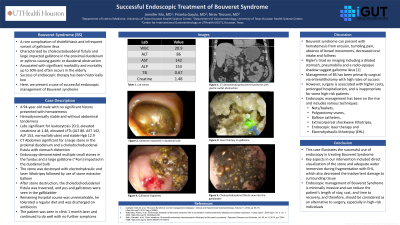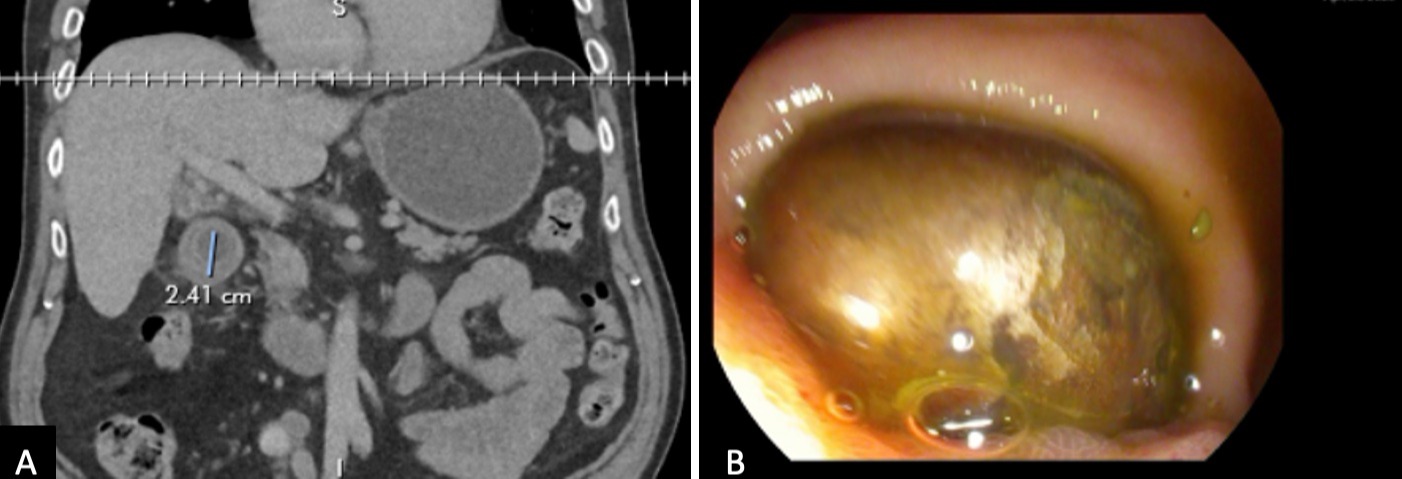Tuesday Poster Session
Category: Interventional Endoscopy
P3744 - Successful Endoscopic Treatment of Bouveret Syndrome
Tuesday, October 24, 2023
10:30 AM - 4:00 PM PT
Location: Exhibit Hall

Has Audio

Jennifer Ma, MD
McGovern Medical School at UTHealth, TX
Presenting Author(s)
Award: Presidential Poster Award
Jennifer Ma, MD, Prianka Gajula, MD, Nirav Thosani, MD
McGovern Medical School at UTHealth, Houston, TX
Introduction: Bouveret syndrome (BS) is a rare complication of cholelithiasis. This occurs when a gallstone creates a cholecystoduodenal fistula and becomes impacted in the proximal duodenum. As a result, gastric or duodenal obstruction can occur and increase morbidity and mortality in this patient population. The success of endoscopic therapy has been historically low, and BS often requires surgical management. Here, we present a case of successful endoscopic management of Bouveret syndrome.
Case Description/Methods: A 94-year-old male with no significant past medical history presented to the hospital with hematemesis. He was hemodynamically stable and without abdominal tenderness. Labs were significant for leukocytosis 20.9, elevated creatinine at 1.48, elevated LFTs (ALT 86. AST 142, ALP 153, normal bilirubin), and stable hemoglobin of 12.9. CT of the abdomen and pelvis was significant for a 2.4cm stone in the proximal duodenum and a choledochoduodenal fistula. The patient was taken for endoscopy, which showed a large gallstone impacted in the duodenal bulb. The stone was successfully destroyed with electrohydraulic, laser, and mechanical lithotripsy. After stone destruction, the choledochoduodenal fistula was traversed. Pus and gallstones were seen in the gallbladder. His hospital course was unremarkable. He was discharged on antibiotics and tolerating a regular diet. The patient was seen in the gastroenterology clinic one month later and continued to do well with no further symptoms.
Discussion: Management of BS is primarily surgical with high rates of success. However, surgery is associated with higher costs, prolonged hospitalization, and is inappropriate for some high-risk patients. Endoscopic management including the use of nets/baskets, extracorporeal shockwave lithotripsy, endoscopic laser therapy, and electrohydraulic lithotripsy (EHL), have been on the rise. Here, we described the successful use of endoscopic techniques to fragment biliary stones. Endoscopy is a minimally invasive option compared to surgery for the management of Bouveret syndrome.

Disclosures:
Jennifer Ma, MD, Prianka Gajula, MD, Nirav Thosani, MD. P3744 - Successful Endoscopic Treatment of Bouveret Syndrome, ACG 2023 Annual Scientific Meeting Abstracts. Vancouver, BC, Canada: American College of Gastroenterology.
Jennifer Ma, MD, Prianka Gajula, MD, Nirav Thosani, MD
McGovern Medical School at UTHealth, Houston, TX
Introduction: Bouveret syndrome (BS) is a rare complication of cholelithiasis. This occurs when a gallstone creates a cholecystoduodenal fistula and becomes impacted in the proximal duodenum. As a result, gastric or duodenal obstruction can occur and increase morbidity and mortality in this patient population. The success of endoscopic therapy has been historically low, and BS often requires surgical management. Here, we present a case of successful endoscopic management of Bouveret syndrome.
Case Description/Methods: A 94-year-old male with no significant past medical history presented to the hospital with hematemesis. He was hemodynamically stable and without abdominal tenderness. Labs were significant for leukocytosis 20.9, elevated creatinine at 1.48, elevated LFTs (ALT 86. AST 142, ALP 153, normal bilirubin), and stable hemoglobin of 12.9. CT of the abdomen and pelvis was significant for a 2.4cm stone in the proximal duodenum and a choledochoduodenal fistula. The patient was taken for endoscopy, which showed a large gallstone impacted in the duodenal bulb. The stone was successfully destroyed with electrohydraulic, laser, and mechanical lithotripsy. After stone destruction, the choledochoduodenal fistula was traversed. Pus and gallstones were seen in the gallbladder. His hospital course was unremarkable. He was discharged on antibiotics and tolerating a regular diet. The patient was seen in the gastroenterology clinic one month later and continued to do well with no further symptoms.
Discussion: Management of BS is primarily surgical with high rates of success. However, surgery is associated with higher costs, prolonged hospitalization, and is inappropriate for some high-risk patients. Endoscopic management including the use of nets/baskets, extracorporeal shockwave lithotripsy, endoscopic laser therapy, and electrohydraulic lithotripsy (EHL), have been on the rise. Here, we described the successful use of endoscopic techniques to fragment biliary stones. Endoscopy is a minimally invasive option compared to surgery for the management of Bouveret syndrome.

Figure: Figure A: CT scan demonstrating Bouveret syndrome with gastric outlet obstruction. Figure B: Demonstrates the endoscopic view of the gallstone impacted in the duodenal bulb
Disclosures:
Jennifer Ma indicated no relevant financial relationships.
Prianka Gajula indicated no relevant financial relationships.
Nirav Thosani: Abbvie – Consultant. Boston Scientific Corp – Consultant. Pentax America – Consultant. ROSEAID inc – Creatorship rights.
Jennifer Ma, MD, Prianka Gajula, MD, Nirav Thosani, MD. P3744 - Successful Endoscopic Treatment of Bouveret Syndrome, ACG 2023 Annual Scientific Meeting Abstracts. Vancouver, BC, Canada: American College of Gastroenterology.


